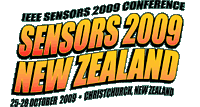

|
Tutorials Micro-Optic and Fiber Optic Sensors Terahertz Sensing Noise Harvesting Chemical and Gas Sensing Industrial Tomography Silicon Piezoresistive Stress Sensors Miniaturised Space Payloads Integrated Gas Sensors Sensors as Communication Channels Nanophotonic Sensors Biopolymer Detection Integrated Radar Sensors Ultrasonics |
During the past years the information and communication theory stimulated emerging novel applications in a broad variety of technology and application fields. Unlike the subject of information-theoretic communication theory, an information-theoretic sensing is far from a mature subject. The use of methods of information theory in problems as the sensor design, data acquisition, sensor networks or sensor data understanding needs the definition of a rigorous framework for stating the sensing problem, introduction of quality and optimality measures, and also for the assessment of methods for information extraction and validation. Meanwhile, the wide spread use of sensors and their diversity rises a new challenge: the information communication to the humans. In his seminal paper "A mathematical theory of communication", Shannon identified and recognized from the very beginning the semantic role of messages, however at that moment he discarded its discussion, only considering as relevant the fact that communication systems shall work independently of the message nature. Today, applying the information theoretical aspects to the sensing problem, consists in the definition of the model for the physical, or process parameters of interest (the source) and an appropriate model for the reproduction space (the destination), the sensor output i.e. the sensor signal contents, up to including also the human semantic interpretation factor. To introduce and demonstrate these concepts for sensor modeling, optimization and design, the tutorial will address the following topics:
Biography Inge Gavat, professor, received the M.S. and Ph.D. degrees in Electronics and Telecommunications from the University "Politehnica" of Bucharest UPB, Romania, in 1963 and 1998. She is currently a Professor at the Department of Applied Electronics and Information Engineering, Faculty for Electronics and Telecommunications, UPB and also at the German Branch of the Faculty of Engineering in Foreign Languages, UPB. She is teaching courses in Information and Estimation Theory, in Communication Theory and in Signal Processing and Artificial Intelligence for Man - Machine Communication. She is often a visiting professor at the Technical University - Darmstadt, Germany, at the University of Rouen, France. She is involved in advanced research projects and programs in pattern recognition with the Romanian Academy of Sciences, with the Military Technical Academy, with the Romanian Space Agency, with the Ministry for Education and Research. She is also involved in bilateral international cooperation with the Technical University of Munich, Germany, University of Maribor, Slovenia, the Rutgers University, N.J., USA. She is developing algorithms for pattern recognition with Markov models, neural networks and fuzzy systems. She worked for recognition applications, with emphasis on man-machine dialog and multimedia applications. Her interest is in stochastic processes conveying information, model-based sequence recognition and understanding, basics of man-machine communication, information managing and retrieval in extended databases. Recently she is involved in several projects in the frame of FP6 Program concerning new technologies to support sustainable humanitarian crisis management using remote sensing imagery and also enhancement of elderly home activities based on lighting techniques controlled by intelligent or optimal algorithms She is coordinator of several ongoing national research and development projects in collaboration with Romanian Space Agency, regarding data mining for floods and other anomaly detection. She is leading projects in intelligent processing of speech, imagery and biological signals. She published over 100 papers regarding speech recognition and understanding, speech enhancement, synthesis and coding, intelligent processing of signals obtained from various types of sensors, application of information theory in the field of data mining and semantic interpretation. |
|||||||
Copyright 2008, All Rights Reserved, IEEE Sensors 2009 and interteq.com